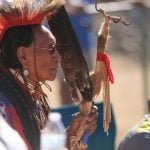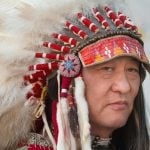President Benjamin Harrison and Indian Reservations

In 1887, Congress passed the General Allotment Act (Dawes Act) which had the intent of assimilating Indians by making them land-owning farmers. The idea of the Dawes Act was to break up the reservations by giving each Indian family an allotment of land, similar to the homesteads given to non-Indian settlers. This act guided much of the Indian policy during the Benjamin Harrison administration (1889-1892).
In 1889, a government commission headed by General George Crook met with the Sioux in South Dakota. Crook provided them lavish feasts, and obtained the needed signatures for the Sioux to cede much of their land.
Over the next two years, the Great Sioux Reservation was broken into six reservations – Cheyenne River, Crow Creek, Lower Brulé, Pine Ridge, Rosebud, and Standing Rock – thus reducing Sioux land holdings. Eleven million acres of land not included in these reservations was returned to the federal government. “Surplus” lands were opened to American settlers. In addition, the railroads were given permission to survey and build lines with no regard for any Sioux concerns.
Congress passed the Nelson Act in 1889 which brought the Dawes Act to bear on the special situation with the Chippewa in Minnesota. At this time, the Chippewa occupied 12 reservations in the state. Under the Nelson Act, the Chippewa were to cede all lands except for the White Earth and Red Lake Reservations. The Chippewa of Red Lake were to take allotments on their own reservations. All other Chippewa in the state were to relocate on the White Earth Reservation and to take their allotments there. All agricultural lands remaining after allotment were to be sold for $1.25 per acre. Timber lands were to be appraised and sold in 40-acre parcels in auction. Money from the sale of lands and timber were to be deposited into a special Chippewa in Minnesota Fund.
Northern Cheyenne:
At the 1851 Fort Laramie Treaty Council, the United States government failed to distinguish between the Northern Cheyenne and the Southern Cheyenne and grouped both tribes together in the south, even though the Northern Cheyenne saw themselves as a distinct people and resisted attempts to relocate them on the Southern Cheyenne reservation in Indian Territory. Following the 1876 Battle of the Little Bighorn, some of the Cheyenne had surrendered to the Army and had worked for them as scouts.
In 1890, Congress created the Northern Cheyenne Commission to find a permanent home for the Northern Cheyenne at the Tongue River in Montana, the Pine Ridge Reservation in South Dakota, or some other reservation. The Commission traveled first to Pine Ridge where they interviewed the 429 Northern Cheyenne who were living there. They then travelled to Lame Deer, Montana where they talked with Northern Cheyenne leaders Two Moon, White Bull, American Horse, Brave Wolf, and Little Wolf. They then continued west to the Crow reservation to discuss with the Crow the possibility of buying land on that reservation for the Northern Cheyenne. The Commission found that the Northern Cheyenne on the Pine Ridge Reservation wanted to unite with their friends and relatives on the Tongue River.
With regard to the Tongue River Agency, the Commission reported that there was hunger and poverty and that the Cheyenne had already eaten their own cattle and were killing some American cattle.
With regard to the Crow, the Commission found them living in a peaceful and prosperous condition. However, they adamantly refused to sell a portion of their reservation to the Cheyenne.
The report submitted by the commission was one of the first times that the government actually possessed extensive, firsthand evidence regarding the situation and possible alternatives for the Northern Cheyenne situation.
Indian Territory:
Since the beginning of the nineteenth century, the policy of the United States government had been to remove Indians west of the Mississippi to Indian Territory. Here the Indians had been told that they would be able to live in peace, without interference from the U.S. government. Soon, however, American greed was demanding these lands as well.
In 1889, Congress authorized the transfer of unassigned lands in Oklahoma to the public domain. As Congress debated the bill, Cherokee principal chief Joel B. Mayes led a delegation to Washington, D.C. to remind lawmakers that the United States had given its solemn word in treaties that territorial jurisdiction was not to be extended over them without their consent. Congress ignored the Indian testimony and passed the Springer Amendment to the Indian Appropriation Bill giving the President the power to open Indian Territory by proclamation.
As one of his first acts as President, Benjamin Harrison announced that part of the Indian Territory in what would later become Oklahoma would be opened to settlement. A three-man commission, known as the Cherokee Commission, was established to negotiate allotment with the Cherokees and other Indian tribes in Oklahoma. A month later, tens of thousands of settlers rushed in to claim land which had formerly belonged to the Creek and Seminole. Over the next few years, 15 million acres of Indian land would be opened to non-Indian settlement.
In meeting with the Cherokee, the Cherokee Commission (also known as the Fairchild Commission) offered the Cherokee $1.25 per acre for their land in the Cherokee Outlet. The total for this offer was nearly the same which the Cherokee Strip Livestock Association would pay for a 15-year lease on the same land.
In 1889, President Benjamin Harrison announced that no livestock would be grazed in the area known as the Cherokee Outlet in Indian Territory. This move deprived the Cherokee Nation of a substantial part of its operating budget and brought an end to their lease with the Cherokee Livestock Association. The move was part of a government effort to get the Cherokee to sell this land.
In 1890, a Harrison issued an executive order which required the Ponca to take allotments even though most tribal members were opposed to it. Ponca traditionalists formed a strong anti-allotment faction.
In 1890, Congress passed the Oklahoma Organic Act which established a territorial government for the western half of Indian Territory and renamed it Oklahoma Territory. Under the Organic Act, the United States annexed all Indian reservations to the new territory.
In 1891 President Harrison opened up 900,000 acres of Oklahoma land for settlement. The land had been owned by the Sauk, Fox, Iowa, and Potawatomi.



